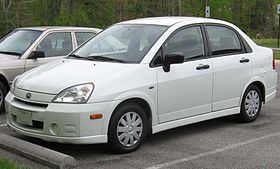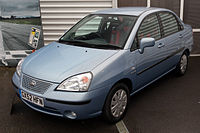Suzuki Aerio
| Suzuki Aerio | |
|---|---|
 | |
| Overview | |
| Manufacturer | Suzuki |
| Also called | Changhe-Suzuki Liana Suzuki Baleno Suzuki Liana |
| Production | 2001–2007 (international) 2005–2018 (China) |
| Assembly | Kosai, Shizuoka, Japan Sagara, Shizuoka, Japan Chongqing, China (Changan Suzuki) Karachi, Pakistan (Pak Suzuki Motor) Bekasi, Indonesia (Suzuki Indomobil Motor) Rome, Georgia, United States (SMAC) |
| Body and chassis | |
| Class | Compact car Mini MPV (hatchback) |
| Body style | 4-door sedan 5-door hatchback |
| Layout | Front-engine,front-wheel-drive / four-wheel drive |
| Powertrain | |
| Engine | 1.3 L M13A I4 1.5 L M15A I4 1.6 L M16A I4 1.8 L M18A I4 2.0 L J20A I4 2.3 L J23 I4 1.4 L DV4 I4 turbodiesel |
| Transmission | 5-speed manual 4-speed automatic |
| Dimensions | |
| Wheelbase | 2,480 mm (97.6 in) |
| Length | 4,230 mm (166.5 in) (hatchback) 4,350 mm (171.3 in) (sedan) |
| Width | 1,690 mm (66.5 in) |
| Height | 1,550 mm (61.0 in) (hatchback) 1,535 mm (60.4 in) (sedan) |
| Chronology | |
| Predecessor | Suzuki Cultus Suzuki Cultus Crescent Suzuki Swift |
| Successor | Suzuki SX4 |
The Suzuki Aerio (called the Liana – Life In A New Age – in China, Pakistan, Europe, Israel, South Asia, Taiwan and Australia or Baleno for sedan version in Indonesia) is a compact car that was built by Suzuki. It was introduced in 2001 as a replacement for the Suzuki Esteem/Baleno, with a tall 5-door SX model hatchback (for maximum inner room efficiency) and a 4-door sedan body. It featured two different 16-valve gasoline inline-four engines, with 1.5 L and 1.8 L, this one capable of 125 PS (92 kW; 123 hp) JIS. Production was discontinued in 2007 around the world and replaced by the Suzuki SX4, except in China where it is built by Changhe-Suzuki since 2005.[1]
Overview[edit]
Models in North America got a larger and more powerful 2.0 L engine with 145 hp (108 kW). A 5-speed manual transmission was standard with a 4-speed automatic optional. All-wheel-drive was available, but only with the automatic. American Aerios came in two trim levels: the S and GS (2002–2004), S and SX (2005), and Base and Premium (2006–2007). Key changes over the years included an upgrade to a new 2.3-liter 155 hp (116 kW; 157 PS) engine in 2004, a major styling and interior refresh in 2005 (replacing the digital instruments with conventional analog ones), and the standardization of antilock brakes in 2006. Only the Aerio sedan remained for 2007, as the hatchback had been shelved to make room for the new 2007 SX4 hatchback. Likewise, the Aerio sedan [called Baleno Next-G in Indonesia] bowed out at year's end, making way for the 2008 SX4 Sport sedan [called Neo Baleno in Indonesia]. Throughout its run, the Aerio was distinct for being the most affordable car in America to offer all-wheel drive.
In Europe, where the car was called Liana (an acronym for Life In A New Age), it was seen as a more affordable alternative to small family cars or to mini MPVs, introducing a new generation of Suzuki M engines, with 1.3 L and 1.6 L I4 engine. All wheel drive was available on the bigger engine. In 2004 the car was restyled with a look that closer resembled the Japanese version, and also received a Diesel engine, with a 16-valve version of the 1.4 L HDi engine supplied by PSA Peugeot Citroën, capable of 90 PS (66 kW; 89 hp) thanks to common rail direct injection and a variable geometry turbocharger.
Changhe-Suzuki in China released a new 1.4L Liana hatchback in October 2010, called Liana a+, which has been sold alongside 1.6L versions.[1] The Liana was facelifted for sedan and hatchback models in April 2013.
The Liana remained in production in Pakistan in 1.3L and 1.6L variants until 2014.
Top Gear[edit]
The Liana was best known[2] for its appearances as the Reasonably Priced Car in Top Gear's Star in a Reasonably-Priced Car segment. Celebrity guests would appear on the show every week to be interviewed and to set a lap time in a saloon model Suzuki Liana. The primary car, along with spare cars, were kept stock except for a roll cage and racing seats which were added as safety measures. In its three-year tenure on Top Gear, the Liana covered 1,600 laps of the circuit; its tires and brakes were changed 100 times; and it required six new clutches, two new hubs, driveshafts, wishbones, struts and gear linkages and a replacement wing mirror.[3] The Liana was used from its first show until its replacement by a Chevrolet Lacetti in the show's spring 2006 season. Until 2015, it enjoyed a partial retirement, and was still brought back when the guest was a Formula 1 driver.
Pikes Peak[edit]
In 2001, Suzuki specially built spaceframe racing car for hillclimb races with a bodyshell to resemble the Aerio dubbed the Suzuki Aerio P950 Pikes Peak Special driven by its rally team manager and former rally driver, Nobuhiro Tajima.
Tajima retired from the race, one mile (1.6 km) short of the finishing line suffering from mechanical failures,[4] teammate Yutaka Awazuhara took the fourth overall in a Grand Vitara.[5]
Tajima would finish as runner up in the All Japan Dirt Trial Championship that year with the same car and won the Race to the Sky hillclimb in 2003,[4] before it was rebuilt as a Grand Vitara, then in 2007 as an XL7, breaking the overall course record at Pikes Peak.[6]
Gallery[edit]
References[edit]
- ^ Jump up to: a b "Changhe-Suzuki Releases 1.4L Liana Hatchback–Liana a+". ChinaAutoWeb.com. 2010-10-18.
- ^ "Star in a Reasonably-Priced Car". Top Gear. Retrieved 2009-07-24.
- ^ "Series 8 episode 1". Top Gear. Series 8. Episode 1. 7 May 2006. BBC Two.
- ^ Jump up to: a b "2001 Pikes Peak International Hill Climb". Global Suzuki. 2001-07-02.
- ^ "Driver's Profile - Nobuhiro "Monster" Tajima". PPIHC. Archived from the original on July 22, 2011. Retrieved 2007-11-19.CS1 maint: unfit url (link)
- ^ "2001 Suzuki Liana (Aerio) Pikes Peak Special". Supercars.net. Retrieved 2007-11-19.
External links[edit]
![]() Media related to Suzuki Aerio at Wikimedia Commons
Media related to Suzuki Aerio at Wikimedia Commons
| show Suzuki automobile timeline, European market, 1980s–present
|
|---|
| show Suzuki road vehicle timeline, North America market, 1985–present
|
|---|

_(front),_Denpasar.jpg)
_(rear),_Denpasar.jpg)




_sedan_(2015-11-11)_01.jpg)
_sedan_(2015-11-11)_02.jpg)


